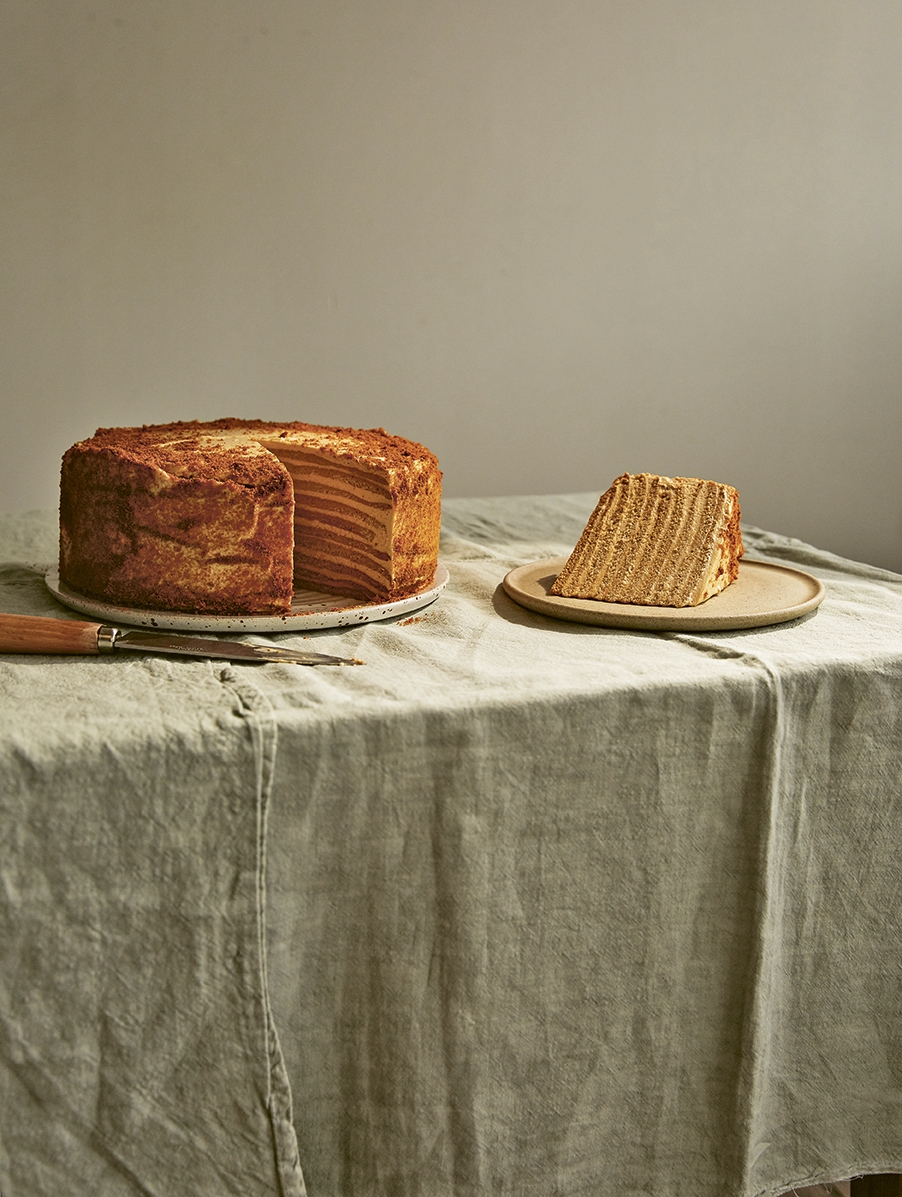Get Premium access to all the latest content online
Subscribe and view full print editions online... Subscribe
Serves 16-20 Desserts and puddings
Make the cake the day before
serving to allow it to chill.
Preheat the oven to 190C/
170C F/Gas 5. Use a dark
marker pen to trace 11 circles
23cm in diameter on to
baking-tray-sized sheets of
baking parchment, using the
base of a springform cake tin to trace around.
For the burnt honey – you can make it ahead, if you like, as it can be kept at room temperature indefinitely – bring the honey to a simmer in a medium saucepan over a medium heat. After a few minutes, it will begin to foam intensely. Stir it occasionally with a wooden spoon and pay close attention: as soon it starts to smoke, reduce the heat to low and cook for another 30 seconds. Remove from the heat and swirl the honey for a minute to release some heat, then set the pan down and add 2tbsp water – be careful; it will steam and sizzle. Once it stops bubbling, give it a stir and pour into a heatproof measuring jug. Stir in enough hot water to make 200ml.
For the cake, in a medium heatproof bowl, combine the honey, 60ml burnt honey, the sugar and butter, and set the bowl over a pan of simmering water. Crack the eggs into a separate bowl and set aside. In a small bowl, combine the bicarbonate of soda, salt and cinnamon. Whisk the honey mixture. When the butter has melted and the mixture is hot to the touch (but not so hot it will burn you), add the eggs all at once, whisking.
Whisk until the mixture becomes hot again, then whisk in the bicarb mixture. The batter will begin to foam and smell a little strange, but that’s normal. Remove from the heat, whisk in 1tbsp cold water and let cool until warm but not hot, then sift in the flour and whisk until completely smooth.
Put a piece of baking parchment, tracing-side-down, on a baking tray. Use an ice- cream scoop or measuring jug to spoon around 90g of batter on to the circle, and use an offset spatula to evenly spread it to the circle’s edges (it will seem like just barely enough batter). On a second baking tray, prepare a second layer. Bake both layers for 6–7 minutes, rotating the sheets halfway through, until they turn a deep caramel colour and spring back to the touch. Be very careful not to overbake.
Repeat with the remaining layers, reducing the bake time by 1-2 minutes if reusing hot baking sheets. When each layer is done, slide the baking parchment off the baking sheet. Peel the cake layers off the parchment while they are still warm, but do not stack them until they’re completely cool.
Reduce the oven temperature to 120C/100C F/Gas 1/2 and allow the cake layers to cool for 30 minutes. Choose your least favourite layer, return it to the oven on a parchment-lined baking tray and bake for around 15 minutes until it turns a deep reddish-brown and becomes very dry. Allow to cool before transferring it a food processor and grinding it to fine crumbs, then set aside.
For the frosting, in a medium bowl, whisk 120ml burnt honey with the dulce de leche and salt. Slowly pour in 180ml of the cream and whisk until smooth. Put in the fridge for around 30 minutes until completely cooled.
In a stand mixer with a whisk attachment, whip the remaining cream to soft peaks for around 6 minutes on a medium speed. Add the cooled honey mixture and whip to medium-stiff peaks. If your mixer holds less than 2 litres, make the frosting in two batches and combine in a large bowl. Put the frosting in the fridge while you assemble the cake.
To assemble the cake, put the first layer on a 25cm cardboard cake circle or a flat serving plate. Spoon 150–160g of frosting on top and use an offset spatula to spread the frosting evenly to the edges. Top with the second cake layer and repeat the frosting and stacking process with all 10 layers. You will need to manoeuvre the cake to align the layers as you continue stacking. If you have a bench scraper and cake turntable, hold the scraper at a right angle from the cake and turn the cake to smooth and straighten as you go.
After the tenth layer, spread a final layer of frosting on the top and use any leftover frosting to smooth out the side of the cake. Gently press the reserved cake crumbs on the sides of the cakes until completely coated. Scatter more crumbs on top,if you like. Put the cake in the fridge overnight and serve chilled. Leftovers can be kept in the fridge for up to 3 days.

Advertisement
Subscribe and view full print editions online... Subscribe